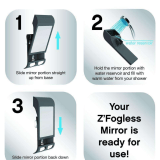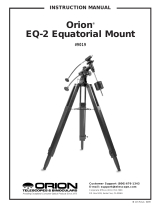
2
Table of Contents
INTRODUCTION ........................................................................................................................................3
ASSEMBLY .................................................................................................................................................6
Setting up the Tripod ................................................................................................................................6
Attaching the Equatorial Mount ...............................................................................................................7
Installing the Counterweight Bar & Counterweights ...............................................................................7
Attaching the Slow Motion Cables...........................................................................................................8
Attaching the Telescope Tube to the Mount.............................................................................................8
Installing the Diagonal & Eyepieces (refractor).......................................................................................9
Installing the Eyepieces on the Newtonians .............................................................................................9
Moving the Telescope Manually ............................................................................................................10
Balancing the Mount in R.A...................................................................................................................10
Balancing the Mount in Dec...................................................................................................................10
Adjusting the Equatorial Mount .............................................................................................................11
Adjusting the Mount in Altitude.............................................................................................................11
TELESCOPE BASICS ...............................................................................................................................12
Image Orientation...................................................................................................................................13
Focusing .................................................................................................................................................13
Aligning the Finderscope........................................................................................................................13
Calculating Magnification ......................................................................................................................14
Determining Field of View.....................................................................................................................15
General Observing Hints ........................................................................................................................15
ASTRONOMY BASICS ............................................................................................................................16
The Celestial Coordinate System............................................................................................................16
Motion of the Stars .................................................................................................................................16
Polar Alignment with Latitude Scale......................................................................................................17
Pointing at Polaris...................................................................................................................................18
Finding the North Celestial Pole ............................................................................................................18
Polar Alignment in the Southern Hemisphere ........................................................................................19
Finding the South Celestial Pole (SCP)..................................................................................................20
Declination Drift Method of Polar Alignment........................................................................................21
Aligning the Setting Circles ...................................................................................................................22
Motor Drive ............................................................................................................................................23
CELESTIAL OBSERVING .......................................................................................................................24
Observing the Moon ...............................................................................................................................24
Observing the Planets .............................................................................................................................24
Observing the Sun ..................................................................................................................................24
Observing Deep-Sky Objects .................................................................................................................25
Seeing Conditions...................................................................................................................................25
ASTROPHOTOGRAPHY..........................................................................................................................26
Short Exposure Prime Focus Photography .............................................................................................26
Piggyback Photography..........................................................................................................................26
Planetary & Lunar Photography with Special Imagers ..........................................................................26
CCD Imaging for Deep Sky Objects ......................................................................................................26
Terrestrial Photography ..........................................................................................................................26
TELESCOPE MAINTENANCE ................................................................................................................27
Care and Cleaning of the Optics.............................................................................................................27
Collimation of a Newtonian ...................................................................................................................27
OPTIONAL ACCESSORIES
...................................................................................................................30
AstroMaster Specifications.....................................................................................................................31





















